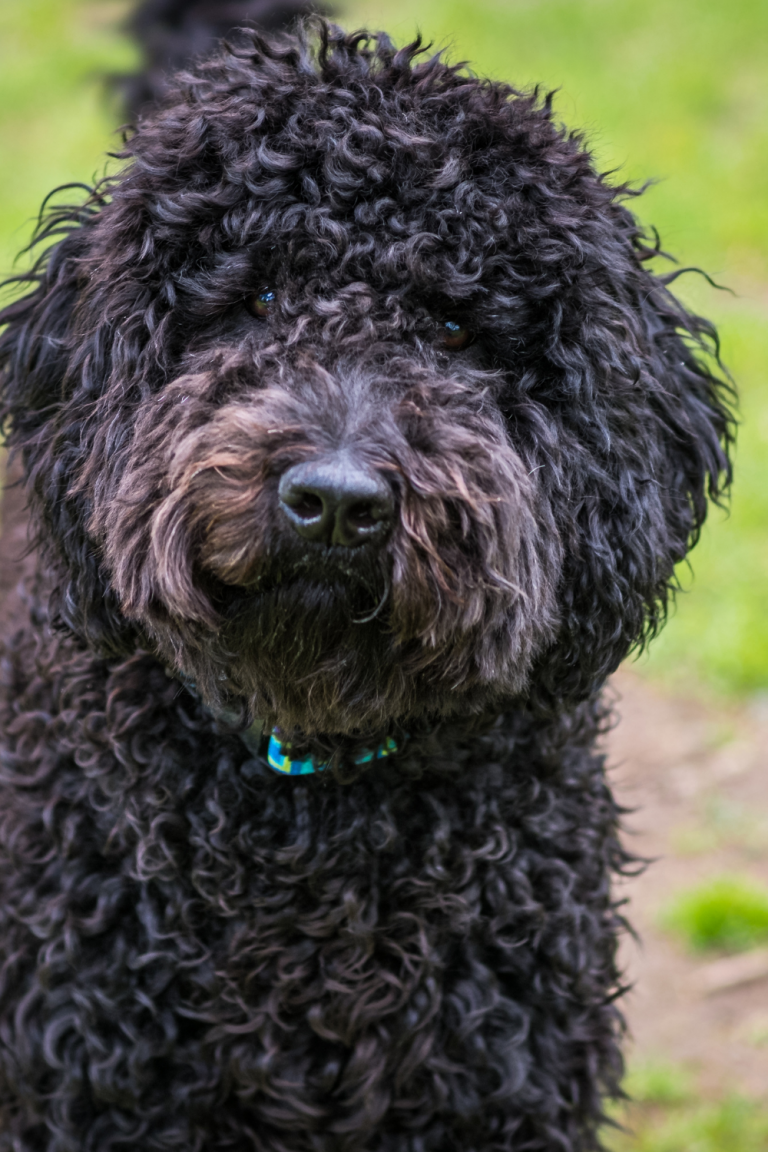
These fuzzy poodle-Labrador retriever hybrids are a common sight at your local dog park, looking like living teddy bears. Labradoodles puppies are adorable, playful and bouncy, always ready for adventure—and a cuddle. These dogs are lap dogs even when they get too big to fit; here are 10 Top reasons to LOVE labradoodles.
Top 9 Reasons to Love Labradoodles
1. Labradoodles are happiest around the people they love
They are understanding, caring, energetic, gentle, intelligent, joyful, and playfu! Labradoodles love their people. They are affectionate and loyal with their family.
A Labradoodle will shower their family with affection and devotion. With the energy of the Labrador Retriever and the work ethic of both the Lab and the Poodle, they’re a joy.
Not surprisingly the Labradoodle has gained such popularity quickly. Originally developed to be hypoallergenic guide dogs, the first planned crosses of Poodles and Labrador Retrievers were arranged by the Royal Guide Dogs Association of Australia.
The result was a smart and sociable dog who displayed a nature for guide dogs and had a low-shedding coat. They are wildly popular and loving dogs. They make an excellent pet for a first-time dog owner.First-time owners do well with the friendly and amenable Labradoodle.
2. Labradoodles are great therapy dogs.
From American households to Australian cities, Labradoodle puppies serve as family pets, guide dogs, service dogs, and therapy dogs.
Labradoodles are able to serve schools, hospitals and rehabilitation centers.A Labradoodle approaches life head-on at breakneck speed, and they approach every new friend with the same enthusiasm.They love cuddles, hugs and kisses.They are friendly and accept and treat everyone like their best friend. They’re devoted to their family and enjoy life as an energetic companion.
They can be gentle, but they can also be joyful, showing their happiness through exuberant jumping and playing. They also tend to be easygoing, since the Labradoodle was bred not to be aggressive. Highly intelligent and sharp as a whip, this breed is in-tune with feelings and actions, learning quickly, displaying loyalty and taking on the role of caretaker.They can also be excellent therapy dogs.

3. Labradoodles come in three sizes.
The Labradoodle comes in three size variations, depending on the size of the Poodle used for the first-generation breeding. The three sizes are Standard, Medium, and Miniature.The males are generally taller than the females.
There is a lot of variation in Labradoodle sizes. Some can be smaller or larger than expected.A Labradoodle is a cross of the Labrador Retriever and the Standard, Miniature, or Toy poodle, also known as Labrador Poodle Mix. The Standard Labradoodle is medium to large dog at about 22 to 24 inches tall, weighing 50 to 65 pounds. The lifespan of this crossbreed is around 12 to 16 years.Depending on whether the Poodle parent is Standard, Miniature or Toy can affect whether the Labradoodle will be one of the following size variations:
- Standard: 24 inches (60 cm) tall; up to 65 lbs (29 kg) in weight.
- Medium: 20 inches (50 cm) tall; up to 45 lbs (20 kg) in weight.
- Miniature: 16 inches (40 cm) tall; up to 25 lbs (11 kg) in weight.
These types of Labradoodles are all based on their size, with the standard Labradoodle being the largest and roughly the same size as the Australian Labradoodle, and as the name implies, the miniature Labradoodle being the smallest.
Height | Weight | |
Miniature Labradoodle | 10-15 in. | 15-20 lbs. |
Standard Labradoodle | Over 20 in. | 40-65 lbs. |
Australian Labradoodle | Over 15 in. | 30-60 lbs. |
4. Labradoodles come in a rainbow of coat colors.
The Labradoodle comes in a wide variety of colors.The Labradoodle can come in a palette of beautiful colors. Possible colors are gold, apricot, caramel, chalk (a chalky white), white, black, red, café, cream, silver, chocolate, parchment, and blue. Some labradoodles have parti-colored coats, which consist of brindles, phantom, patched, or sable colors.
5. Labradoodles have a variety of coats.
The coat is where one of this hybrid’s variety shows. There are 3 different coat types associated with labradoodles:
- Straight coat: Also known as the “hair coat” this one sheds the most and is avoided by breeders.
- Wavy coat: Also known as the “fleece coat”, expect silky waves and non-to-low shedding.
- Curly coat: Dense, thick curls that have no odor and are non-shedding.
The Labradoodle was meant to be low-shedding, like the Poodle, but it’s still common to have more than one coat type, as well as variation in puppy sizes, within one litter. There are three types of texture:
The Hair coat, which is similar to fur in shedding breeds, is the least popular. Hair coats shed and usually have a normal doggy odor. This coat is seen in first generations, although breeders try to avoid it.
The second texture, called a Wool coat, is dense and similar in feel to a lamb’s wool, hence its descriptive name. Wool coats hang in loose curls and aren’t dense. Generally, the Wool coat doesn’t have a “doggy” odor and it’s usually non shedding.
The Fleece coat has a silky texture often described as an Angora goat texture. This coat ranges from straight to wavy.
Labradoodles are considered to be non- to low shedders, especially those with a Fleece or Wool coat. Hair coats tend to shed just as they do in other breeds, ranging from very low to average shedding.
6. Labradoodle love to exercise and play.
The Labradoodle makes an excellent jogging companion but also needs some time off-leash to burn off steam. Labradoodles love a good walk or active playtime each day, and, if you’re interested, they are athletic enough to participate in such dog sports as agility, flyball, obedience, and rally.
Because of their size and energetic personality, plenty of space is recommended for a Labradoodle to blow off steam. That means small apartments and long hours in a crate do not benefit this stimulated hybrid.A space to run around like big backyards and parks are perfect.
Take your Labradoodle out for a jog or let her splash in your swimming pool. Homes with a fenced in yard are ideal for your dog to have some off-leash time to run about and frolic freely.
7. Labradoodle is a good family dog.
They were bred for accompaniment. Labradoodles are patient, friendly, and affectionate. They love being petted and hugged. They are playful, gentle, and sociable. Bred to be a hypoallergenic service dog, the Labradoodle went on to prove that they could also be a versatile family and therapy dog as well.
The Labradoodle is an intelligent and eager-to-please dog.Despite their activity levels, a Labradoodle can adjust to living in suburban or city environments and can do well in rural settings. Although they are used for various working roles, they’re a companion dog through and through. They’re happiest living in the comforts of home, sleeping soundly on your feet or in a bed next to yours.They do well with other dogs and pets in the household, and they’re generally good with children.Labradoodles are playful and very loving with children, but they can be overly exuberant and may knock down younger children unintentionally.These dogs make great family pets: happy and easy to train.
8. Labradoodle’s grooming and nail care are not high maintenance
Labradoodles need twice a week brushing, as well as regular grooming that includes ear cleaning, nail clipping and regular vet visits. If you’re not experienced trimming dog nails, ask a vet or groomer for pointers.
Grooming needs depend on the length and type of coat the dog has. Some can be clipped or trimmed every six to eight weeks to keep the coat easy to maintain. A Labradoodle should only be bathed when necessary –which is not often, as many of the coats do not have a noticeable doggy odor.
Like Labs, Labradoodles can be prone to ear infections, so take a little extra time caring for their ears. Dry and clean them after a swim, and check them once a week for dirt, redness, or a bad odor that can indicate an infection. Then wipe them out weekly with a cotton ball dampened with gentle, pH-balanced ear cleaner to prevent problems.
A labradoodle needs their teeth brushed at least two or three times a week to remove tartar buildup and the bacteria that lurk inside it. Daily brushing is even better if you want to prevent gum disease and bad breath.
When a labradoodle is a puppy, help them to enjoy being brushed and examined. Handle their paws frequently–dogs are touchy about their feet–and look inside their mouth. Make grooming a positive experience filled with praise and rewards. You will lay the groundwork for easy veterinary exams and other handling when they’re an adult.
As you groom, check for sores, rashes, or signs of infection such as redness, tenderness, or inflammation on the skin, in the nose, mouth, and eyes, and on the feet. Their eyes should be clear, with no redness or discharge. Your careful weekly exam will help you spot potential health problems early.
9. Labradoodles are easy to train
A Labradoodle is easy to train, because they are eager to please and smart.Training should be easy as long as consistency and positive reinforcement are the methods. They can make a good companion for first-time dog owners since they do not need an overly firm hand. Socialize them from puppyhood, since they tend to hurl themselves headlong into canine situations without regard to the feelings of other dogs.
Since both poodles and Labradors are known for their intelligence, it’s no surprise that Labradoodles are highly trainable. They’re eager to learn, and training helps keep their mischievous side at bay.
